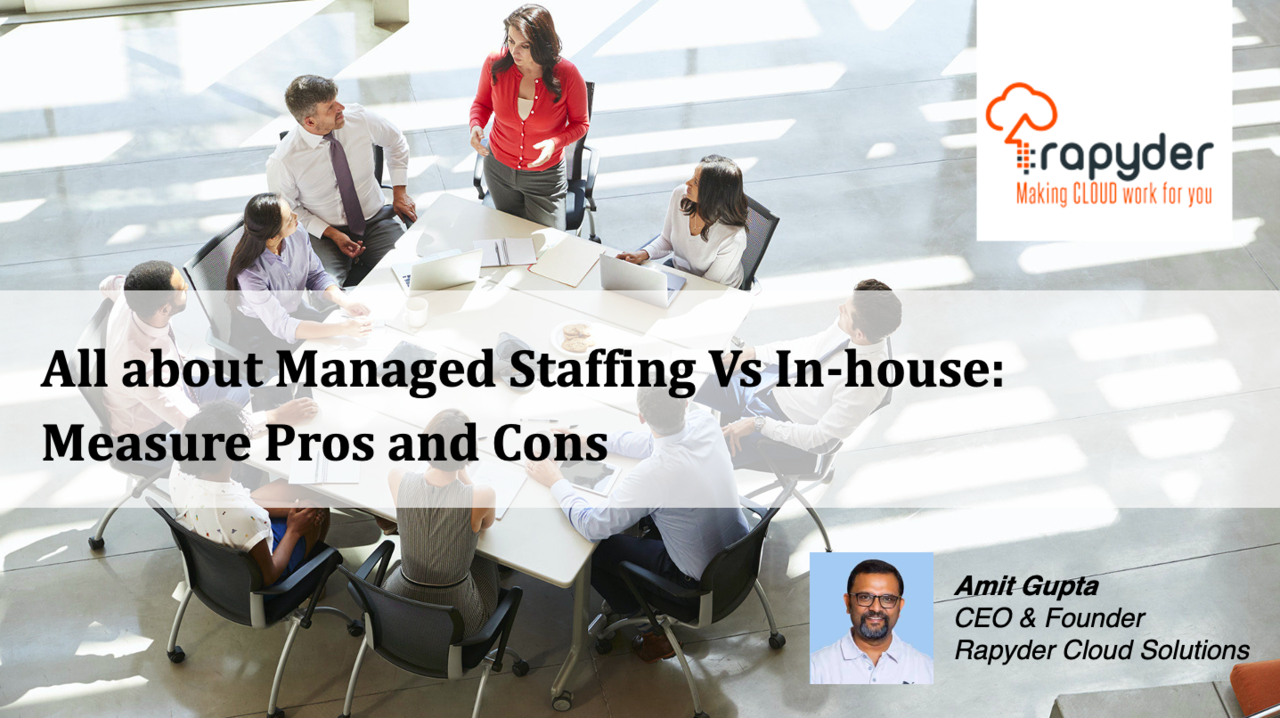All about Managed Staffing Vs In-house: Measure Pros and Cons - Amit Gupta, CEO & Founder, Rapyder Cloud Solutions

Hiring the best suitable candidate or outsourcing a talent is an age-old debate for enterprises and staffing decision-makers. In an aggressive business environment where accelerating revenues, minimising cost and streamlining operations is critical, decision-makers are usually challenged with a vital question - managed staffing or in-house hiring, which is better?
While both scenarios offer a list of positives and negatives, it is better to have a complete understanding of the pros and cons to choose an apt solution.
Let’s have a look at the pros and cons of having an in-house team vs outsourcing talent.
Scenario 1: In-House Hiring
Pros:
· In-house staff is exclusive to the company. This allows quick response, onsite availability, and a systematic approach to problems or solutions. Face-to- face interaction offers better engagement between employees and employers. These personalised conversations lead to better execution and implementation of solutions.
· Additionally, it also offers absolute control to organizations over staffing and critical HR issues. A constant salary and room for growth directly impact the retainability of in-house members and such members are associated for a longer duration with the organization.
· Maintaining confidentiality concerning intellectual property becomes easy. Legal non-compete contract prevents leakage of any confidential information.
· Technical issues are resolved quickly as the talent is available onsite and is responsible for the smooth functioning of the organization.
· Creates trust in the market as potential investors, customers or revenue generators show more interest in in-house teams and technology. This boosts overall company valuation.
Cons:
· Scouting for the best suitable talent can be tough, especially in smaller cities.
· Cost per talent is high as suitable candidates expect more salary and additional benefits.
· Searching, interviewing, and onboarding a talent takes time & resources, and so does overlooking them.
· The in-house team also needs management which results in higher overheads and additional costs.
· The cost of maintaining an employee during business downtime also adds up to the overall budget
Scenario 2: Managed Staffing
Pros:
· With managed staffing, the cost is predictable and budget-friendly. There is no additional price, such as medical benefits or bonuses attached to managed staffing. The company only needs to pay for the services selected during onboarding a managed service provider.
· Managed service providers are experts at recognising respective business requirements and providing a staffing package that best suits the company’s business needs. These services are offered under a serviced agreement, thus, ensuring zero burdens to the company.
· Managed staffing offers unmatched subject-matter expertise and market experience. With great exposure to different domains, outsourcing service providers are capable of providing the best solution and approach to an issue.
Cons:
· The risk of losing intellectual property is always there.
· Unavailability of staff at the company’s location can be challenging in some situations.
· The communication gap can cause a serious crisis if not resolved quickly.
· Managed staffing with the best solution can be a bit expensive.
· Timely delivery of solutions or work can be an issue in some situations.
How do we decide between managed staffing vs in-house?
Three vital factors determine a company’s hiring approach to in-house onboarding or managed staffing:
1. Cost
2. Expertise
3. Flexibility
What is the best solution?
Having a blended approach is the best solution when it comes to hiring talent. While in-house onboarding might not be the best solution for small businesses or startups, it might just be the right solution for companies looking to have a team.
It is important to understand that both, in-house hiring and managed staffing’ are not exclusive solutions. Businesses need to use them simultaneously to attain maximum benefit and goal attainability.
Furthermore, scenarios like COVID have compelled human resources to think differently when it comes to onboarding a talent. When the world is going remote and office spaces are sparsely open, having a hybrid approach is essential for the future.



